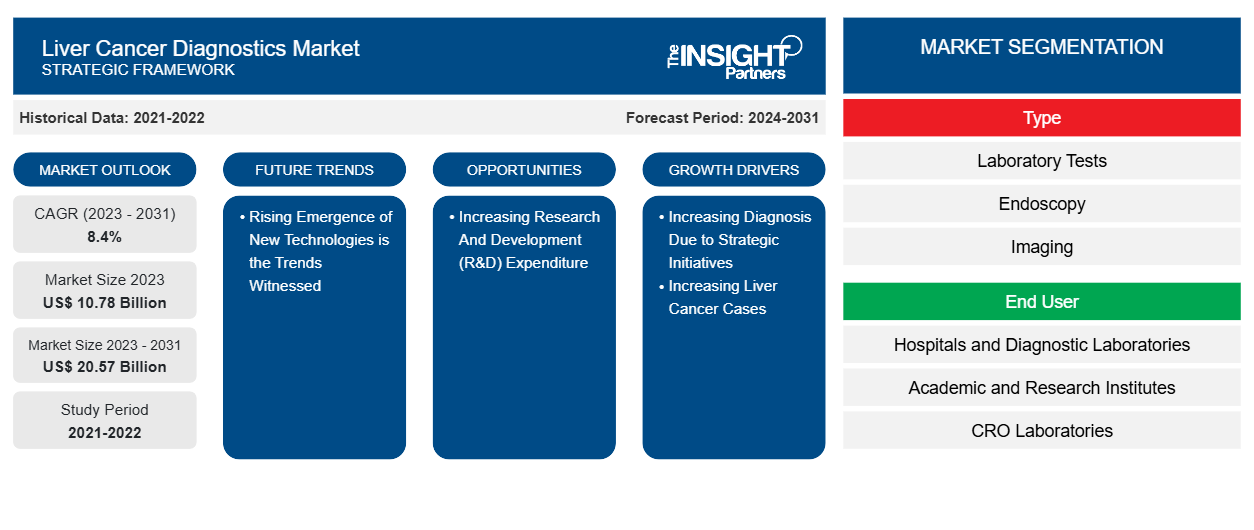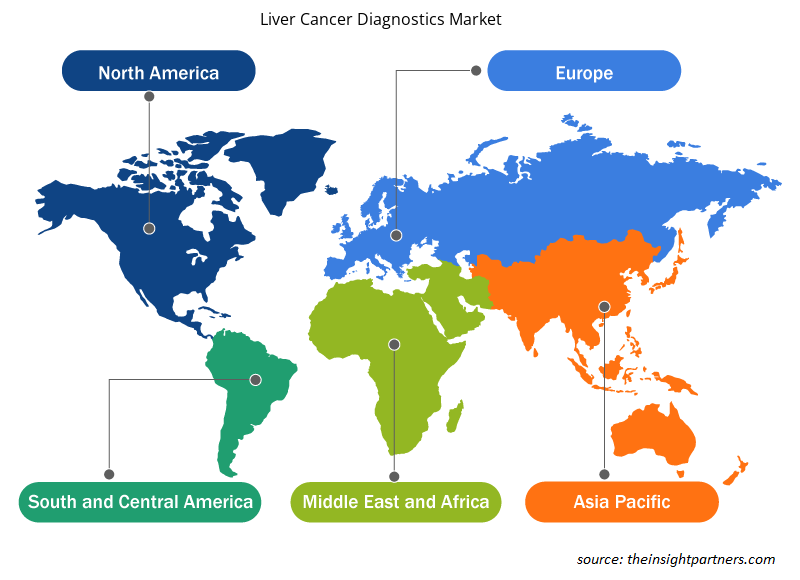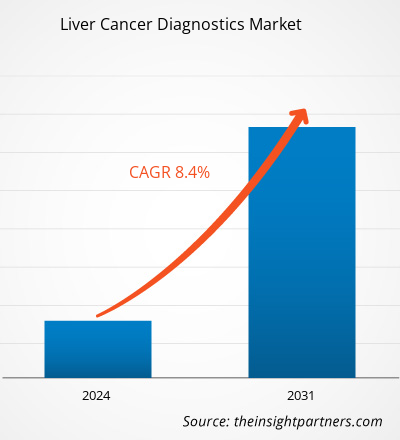The liver cancer diagnostics market size is projected to reach US$ 20.57 billion by 2031 from US$ 10.78 billion in 2023. The market is expected to register a CAGR of 8.4% during 2023–2031. The rising emergence of new technologies is likely to remain a key trend in the market.
Liver Cancer Diagnostics Market Analysis
As per the CDC, each year in the United States, approximately 24,500 men and 10,000 women develop liver cancer, out of which 18,600 men and 9,000 women die from the disease. The cases of Americans getting liver cancer are rising for several decades. Hepatocellular carcinoma (HCC) is the most common liver cancer in the US. Furthermore, according to the Canada Government, about 1 in 4 Canadian adults (26.6%) are currently living with obesity. Obesity cases are also increasing and with increasing csaes the risk of certain health conditions such as liver damage, diabetes, high blood pressure, and heart disease are also rising.
Liver Cancer Diagnostics Market Overview
In the year 2020, the World Health Organization (WHO) stated that in worldwide, over 10 million deaths happened, out of which one in every six deaths are due to cancer. Additionally, in 2020, liver cancer is one of the most common cancer types, accounting for around 4.7% of all new cancer cases and 8.3% of all cancer deaths. Out of all diagnosed liver cancer cases, 75% to 90% are Hepatocellular carcinoma (HCC) ), which has a more significant impact on cancer-related fatalities. According to the published article in CCO (Chinese Clinical Oncology), hepatocellular cancer (HCC) is a top cause of cancer death worldwide. The most often used procedures for HCC screening are the serum alpha-fetoprotein (AFP) test and liver ultrasound. However, by sensitivity, AFP test has a sensitivity of 25% to 65%, and ultrasound has a sensitivity of over 60%. Liver cancer is a more common cancer, and the cases are increasing. For instance, in the UK, mortality rates from HCC is expected to rise by 14% by 2025, representing the largest increase in any cancer.
Customize This Report To Suit Your Requirement
You will get customization on any report - free of charge - including parts of this report, or country-level analysis, Excel Data pack, as well as avail great offers and discounts for start-ups & universities
Liver Cancer Diagnostics Market: Strategic Insights

- Get Top Key Market Trends of this report.This FREE sample will include data analysis, ranging from market trends to estimates and forecasts.
You will get customization on any report - free of charge - including parts of this report, or country-level analysis, Excel Data pack, as well as avail great offers and discounts for start-ups & universities
Liver Cancer Diagnostics Market: Strategic Insights

- Get Top Key Market Trends of this report.This FREE sample will include data analysis, ranging from market trends to estimates and forecasts.
Liver Cancer Diagnostics Market Drivers and Opportunities
Increasing Diagnosis Due to Strategic Initiatives to Favor Market
In June 2020, NCI scientists developed new test for screening hepatocellular carcinoma (HCC), the most common form of liver cancer. This screening involves blood test for investigation of the patient’s previous exposure to certain viruses. Such screening leads to early detection and diagnosis, mainly because cancers in the late or advanced stages are detected, and by then, they are often incurable. Furthermore, NCI also launched the CCR Liver Cancer Program to develop new methods for early detection, diagnosis, and treatment, with the aim to improve HCC patients’ outcomes. Additionally, the National Institutes of Health (NIH) started its clinical trials network to evaluate possible aids and problems of promising new cancer screening technologies and to govern the efficient methods for integrating these innovations into standard care protocols.
Increasing Research And Development (R&D) Expenditure
In 2021, Elecsys GALAD research and development (R&D) expenditure was US$ 14.65 billion and in 2020 it was US$ 13.17 billion. It has increased by 14% on a core basis. Furthermore, F. Hoffmann-La Roche Ltd R&D have increased mainly for late-stage investments in oncology, ophthalmology, and personalized healthcare. Additionally, in June 2020, scientists from National Institutes of Health (NIH) launched blood tests to improve liver cancer screening which are managed by researchers at the National Cancer Institute (NCI). Therefore, the mounting R&D investments and development of diagnostic tests for liver cancer are driving the liver cancer diagnostics market.
Liver Cancer Diagnostics Market Report Segmentation Analysis
Key segments that contributed to the derivation of the liver cancer diagnostics market analysis are type and end-user.
- Based on type, the market is divided into laboratory tests, endoscopy, imaging, biopsy, and others. The laboratory tests segment held a larger market share in 2023.
- Based on the end user, the market is divided into hospitals and diagnostic laboratories, academic and research institutes, and CRO laboratories. The hospitals and diagnostic laboratories segment held a larger market share in 2023.
Liver Cancer Diagnostics Market Share Analysis by Geography
The geographic scope of the liver cancer diagnostics market report is mainly divided into five regions: North America, Asia Pacific, Europe, Middle East & Africa, and South & Central America.
North America has dominated the market and Asia Pacific is anticipated to grow with the highest CAGR in the coming years. The growth of the Asia Pacific market is due to rising senior populations and expanding liver cancer treatment options. Due to the implementation of improved diagnostic procedures for liver cancer in countries such as India and China, the APAC region is expected to have the highest CAGR. As the cost-effectiveness of diagnostic solutions improves, demand for liver cancer diagnostics in independent diagnostic laboratories in APAC is predicted to rise. The above factors will propel the liver cancer diagnostics market.
Liver Cancer Diagnostics Market Regional Insights
The regional trends and factors influencing the Liver Cancer Diagnostics Market throughout the forecast period have been thoroughly explained by the analysts at The Insight Partners. This section also discusses Liver Cancer Diagnostics Market segments and geography across North America, Europe, Asia Pacific, Middle East and Africa, and South and Central America.

- Get the Regional Specific Data for Liver Cancer Diagnostics Market
Liver Cancer Diagnostics Market Report Scope
| Report Attribute | Details |
|---|---|
| Market size in 2023 | US$ 10.78 Billion |
| Market Size by 2031 | US$ 20.57 Billion |
| Global CAGR (2023 - 2031) | 8.4% |
| Historical Data | 2021-2022 |
| Forecast period | 2024-2031 |
| Segments Covered |
By Type
|
| Regions and Countries Covered | North America
|
| Market leaders and key company profiles |
Liver Cancer Diagnostics Market Players Density: Understanding Its Impact on Business Dynamics
The Liver Cancer Diagnostics Market is growing rapidly, driven by increasing end-user demand due to factors such as evolving consumer preferences, technological advancements, and greater awareness of the product's benefits. As demand rises, businesses are expanding their offerings, innovating to meet consumer needs, and capitalizing on emerging trends, which further fuels market growth.
Market players density refers to the distribution of firms or companies operating within a particular market or industry. It indicates how many competitors (market players) are present in a given market space relative to its size or total market value.
Major Companies operating in the Liver Cancer Diagnostics Market are:
- Abbott,
- BioMerieux SA,
- F. HOFFMANN-LA ROCHE LTD,
- Illumina, Inc.,
- Koninklijke Philips N.V,
- QIAGEN,
Disclaimer: The companies listed above are not ranked in any particular order.

- Get the Liver Cancer Diagnostics Market top key players overview
Liver Cancer Diagnostics Market News and Recent Developments
The liver cancer diagnostics market is evaluated by gathering qualitative and quantitative data post primary and secondary research, which includes important corporate publications, association data, and databases. A few of the developments in the liver cancer diagnostics market are listed below:
- Illumina, Inc. launched TruSight oncology test for assessing multiple tumor genes and biomarkers. The TruSight test will soon begin its global launch in Europe. It assesses the tumor genes and biomarkers to discover the specific molecular profile of a patient’s cancer, helping to inform precision medicine decisions. (Source: Illumina, Inc., Press Release, March 2022)
- Perspectum entered a partnership with HepQuant to provide delivery of HepQuant’s liver function evaluation technology via Perspectum’s Contract Research Organization (CRO) services. This collaboration enabled pharmaceutical companies backing clinical trials for liver disease, including liver cirrhosis, non-alcoholic steatohepatitis (NASH), autoimmune liver diseases, and liver cancer to receive imaging and function testing knowledge from Perspectum’s Pharma Solutions. (Source: Perspectum, Press Release, November 2021)
Liver Cancer Diagnostics Market Report Coverage and Deliverables
The “Liver Cancer Diagnostics Market Size and Forecast (2021–2031)” report provides a detailed analysis of the market covering below areas:
- Liver cancer diagnostics market size and forecast at global, regional, and country levels for all the key market segments covered under the scope
- Liver cancer diagnostics market trends, as well as market dynamics such as drivers, restraints, and key opportunities
- Detailed PEST/Porter’s Five Forces and SWOT analysis
- Liver cancer diagnostics market analysis covering key market trends, global and regional framework, major players, regulations, and recent market developments3
- Industry landscape and competition analysis covering market concentration, heat map analysis, prominent players, and recent developments in the liver cancer diagnostics market
- Detailed company profiles
Frequently Asked Questions
Which region dominated the liver cancer diagnostics market in 2023?
North America has dominated the Liver Cancer Diagnostics market.
What are the driving factors impacting the liver cancer diagnostics market?
Factors such as increasing diagnosis due to strategic initiatives and incasering liver cancer cases will boost the market growth.
What are the future trends of the liver cancer diagnostics market?
The rising emergence of new technologies is likely to remain a key trend in the market.
What would be the estimated value of the liver cancer diagnostics market by 2031?
The liver cancer diagnostics market size is projected to reach US$ 20.57 billion by 2031.
What is the expected CAGR of the liver cancer diagnostics market?
The market is expected to register a CAGR of 8.4% during 2023–2031.
- Historical Analysis (2 Years), Base Year, Forecast (7 Years) with CAGR
- PEST and SWOT Analysis
- Market Size Value / Volume - Global, Regional, Country
- Industry and Competitive Landscape
- Excel Dataset
Testimonials
Reason to Buy
- Informed Decision-Making
- Understanding Market Dynamics
- Competitive Analysis
- Identifying Emerging Markets
- Customer Insights
- Market Forecasts
- Risk Mitigation
- Boosting Operational Efficiency
- Strategic Planning
- Investment Justification
- Tracking Industry Innovations
- Aligning with Regulatory Trends
Yes! We provide a free sample of the report, which includes Report Scope (Table of Contents), report structure, and selected insights to help you assess the value of the full report. Please click on the "Download Sample" button or contact us to receive your copy.
Absolutely — analyst assistance is part of the package. You can connect with our analyst post-purchase to clarify report insights, methodology or discuss how the findings apply to your business needs.
Once your order is successfully placed, you will receive a confirmation email along with your invoice.
• For published reports: You’ll receive access to the report within 4–6 working hours via a secured email sent to your email.
• For upcoming reports: Your order will be recorded as a pre-booking. Our team will share the estimated release date and keep you informed of any updates. As soon as the report is published, it will be delivered to your registered email.
We offer customization options to align the report with your specific objectives. Whether you need deeper insights into a particular region, industry segment, competitor analysis, or data cut, our research team can tailor the report accordingly. Please share your requirements with us, and we’ll be happy to provide a customized proposal or scope.
The report is available in either PDF format or as an Excel dataset, depending on the license you choose.
The PDF version provides the full analysis and visuals in a ready-to-read format. The Excel dataset includes all underlying data tables for easy manipulation and further analysis.
Please review the license options at checkout or contact us to confirm which formats are included with your purchase.
Our payment process is fully secure and PCI-DSS compliant.
We use trusted and encrypted payment gateways to ensure that all transactions are protected with industry-standard SSL encryption. Your payment details are never stored on our servers and are handled securely by certified third-party processors.
You can make your purchase with confidence, knowing your personal and financial information is safe with us.
Yes, we do offer special pricing for bulk purchases.
If you're interested in purchasing multiple reports, we’re happy to provide a customized bundle offer or volume-based discount tailored to your needs. Please contact our sales team with the list of reports you’re considering, and we’ll share a personalized quote.
Yes, absolutely.
Our team is available to help you make an informed decision. Whether you have questions about the report’s scope, methodology, customization options, or which license suits you best, we’re here to assist. Please reach out to us at sales@theinsightpartners.com, and one of our representatives will get in touch promptly.
Yes, a billing invoice will be automatically generated and sent to your registered email upon successful completion of your purchase.
If you need the invoice in a specific format or require additional details (such as company name, GST, or VAT information), feel free to contact us, and we’ll be happy to assist.
Yes, certainly.
If you encounter any difficulties accessing or receiving your report, our support team is ready to assist you. Simply reach out to us via email or live chat with your order information, and we’ll ensure the issue is resolved quickly so you can access your report without interruption.





















 Get Free Sample For
Get Free Sample For